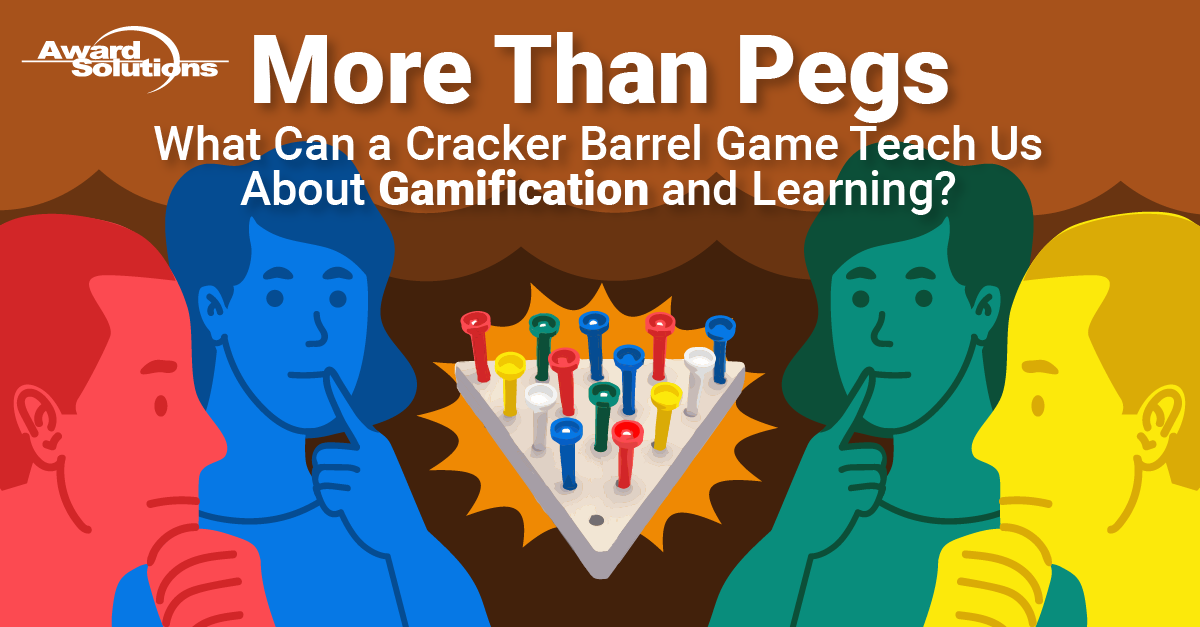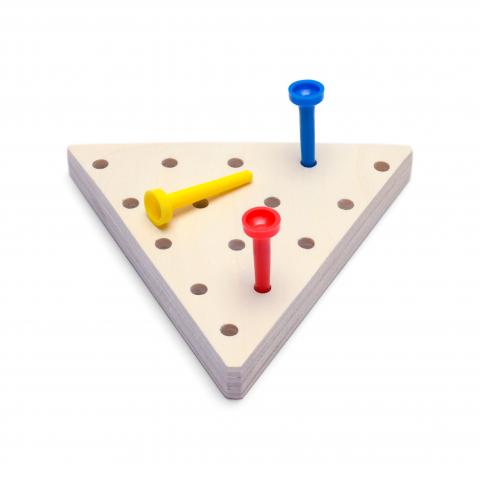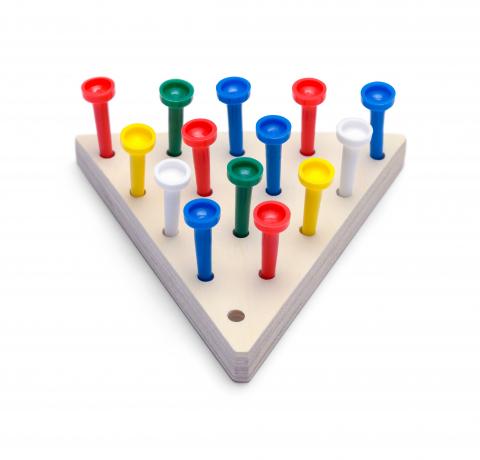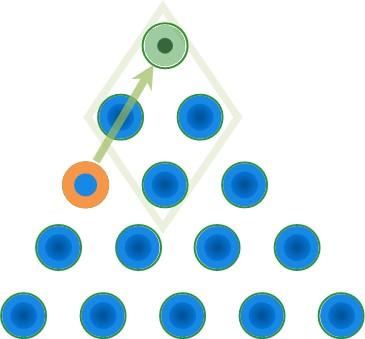
Have you ever been to Cracker Barrel? I mean the restaurant, of course, not a literal barrel of crackers. Even if you haven't been there, you probably noticed one since they are always located off the highway. Look for the iconic wooden porch laden with an impossible number of rocking chairs. After you cross the porch and walk through a gift shop filled with holiday ornaments and candy from the past, you may notice a game at your table: a triangle of wood with holes containing little pegs.

The rules for the game are printed on the back of the wooden triangle and read as follows:
JUMP ALL BUT ONE GAME: Jump each tee and remove it.
Leave only one – You're GENIUS
Leave two – You're PURTY SMART
Leave three – You're JUST PLAIN DUMB
Leave four or more – You're an EG-NO-RA-MOOSE
One day, as I sat at Cracker Barrel with a glass of sweet tea, patiently awaiting the arrival of biscuits, I had a moment to contemplate the significance of that small wooden board. What is fascinating about jumping pegs over one another to remove them? Why are we so thrilled when we win? Why do we play games? And, most importantly, what is an EG-NO-RA-MOOSE?
Let's look at this little game more closely.
The History of Peg Solitaire

Legend has it that a French mathematician invented the game to entertain a king. The first evidence of the game can be traced back to the court of Louis XIV, and the specific date of 1697, from an engraving by Claude Auguste Berey of Anne de Rohan-Chabot, Princess of Soubise, with the puzzle by her side. Considering it's fit for royalty, it's no surprise that Cracker Barrel keeps one on every table.
Peg Solitaire and Problem Solving
Getting the puzzle right and saving your reputation for not being an "eg-no-ra-moose" relies on luck and strategic planning. Certain patterns and strategies work better than others. As you learn the game, you begin to consider strategic routes through the puzzle using problem-solving scenarios. That might work for some people, but after a few tries, I looked up some instructions on WikiHow.
While there are many opening positions and approaches to winning the game, I've selected an approach that begins with the first empty peg in one corner of the puzzle for our purposes. Don't worry; even though we are limiting this topic to one approach, you will still be declared a "genius" at your next weekend brunch.

Peg Solitaire as a Learning Experiment
Think of this as more of an experiment than a blog. Why do people like games, and how can we harness that to help them learn? Does gamification really work?
Let's see what we can learn about gamification from a game with wooden pegs.
Set Clear Goals and Objectives
One of the fundamental principles of gamification is setting clear goals and objectives. The game board at Cracker Barrel explains that the aim is to finish the game with only one peg on the board. So, what is the objective of our experiment? This blog has two goals, and the game link is attached. First, practicing the digital version of the game and learning some board patterns will help you impress your friends and family by winning peg solitaire at Cracker Barrel or wherever else you may encounter the game. Secondly, you can implement the psychological principles behind gaming to develop more effective training.
Design the Game Mechanics
This is where we define the rules of the game. The directions on the wooden board, "jump each tee and remove it," explain in a few words how to play. In our virtual peg game, we include instructions to guide the player to remove pegs by jumping one over another. To adapt this mechanic to suit our learning objectives, we will include review questions based on this material as part of the process. By providing instructions and examples to players, we can make it easy to understand how the game works.

Set Achievement Milestones
Even with the minimal instructions printed on the back of a small wood triangle, the Cracker Barrel game breaks down achievement milestones. As you move pegs around the board, you gradually increase your rank until you reach the "purty smart" and "genius" levels. This allows you to feel you are making progress and keeps you motivated to finish the game.
For our experiment, we will break down the game into four increments based on patterns that will help you win the game.

Applying this concept to learning in general, you can break down the learning experience into smaller milestones or achievements to keep users from being overwhelmed. These milestones are checkpoints that keep your players on track and motivated.
Incorporate Rewards and Feedback
The Cracker Barrel game assigns the reward of declaring you a "genius" or "purty smart" if you do well. And, "just plain dumb" or "EG-NO-RA-MOOSE" if you don't. While I don't think we should call anyone dumb if they don't progress, we can use this model to offer rewards or feedback for completing levels within our virtual game. In our game version, we will use fictitious prizes from a virtual Cracker Barrel store to assign as rewards for each milestone.

For learning in general, gamification teaches us the importance of providing immediate feedback on learner performance. For every action or task completed, we will let the learner know how they did and what they earned. Receiving feedback, whether confirming the accuracy of a response or pointing out an error, offers players insights into their performance, helping them learn and improve. The goal is to create a positive and motivating learning experience.
Putting it All Together
What can the peg game at Cracker Barrel teach us about gamification?
First, the game provides one clear objective: removing as many pegs as possible from the board. Objectives and goals in gamification are essential because they give players a sense of purpose and direction. When players know what they are working toward and need to achieve, it enhances their motivation to participate and engage in the game.
The game mechanics of the wooden peg game are clear: pulling one peg out of position, you can use it to jump over another peg to remove it from the board. Game mechanics define the rules, interactions, and systems that make the game enjoyable and meaningful. When game mechanics are well-designed, they provide clarity, consistency, and a sense of purpose for players.
The game uses the number of pegs left on the board during play to set achievement milestones, providing progress markers for the players. Achieving milestones creates a sense of achievement, which can be highly motivating and encourages players to continue striving toward their goals. These milestones can also break down a larger task or objective into manageable parts.
The game incorporates feedback, teasing you if you leave too many pegs in place and rewarding you with the title of "genius" when you succeed. Rewards and feedback in gamification enhance motivation, engagement, and a sense of achievement among players. Rewards serve as incentives and tangible progress markers, encouraging players to participate in the game actively. Feedback reinforces players' actions and accomplishments or lets them know when they have made mistakes.
By understanding the principles behind this deceptively simple game, we can design learning experiences that set clear goals, provide well-designed game mechanics, break down complex tasks into achievable milestones, and provide immediate rewards and feedback.
Shall we play a game?
Follow this link to play the peg game and test your knowledge for applying gamification concepts to online learning:.
About Lisa Stringer
Lisa Stringer is a digital learning designer at Award Solutions, where she creates stories to help people learn more about technology topics like Python, cyber security, and 5G.
About Award Solutions, Inc.
Award Solutions is the trusted training partner to the world's best networks. We help companies tackle new technologies by equipping their teams with knowledge and skills. Award Solutions invests heavily in technology, research, engineering, and labs to ensure our customers make the most of their resource and network investments.
Award’s expertise extends across many technologies including 5G/LTE Access 5G/4G Core, VoNR/VoLTE, Transport Networks, Telco Cloud, Virtualization and Orchestration, Data Automation, and more.
